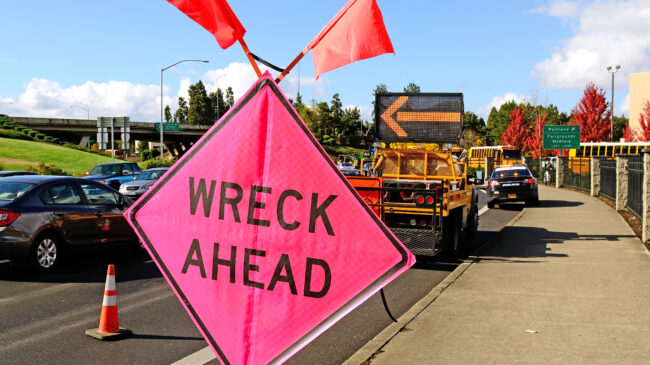If a drunk driver hits a pedestrian, who is at fault? Alternatively, who is at fault if a driver hits a drunk pedestrian? Some Vision Zero and Complete Streets advocates have started to suggest some of the blame goes to the people who designed the road.
For example, in a recent post, Charles Marohn, president of Strong Towns, a self-described media advocacy organization focused on livable development, analyzes a mix of real-world and hypothetical examples to suggest issues with post-crash analysis, what elements are considered and not considered, and problems he has with the current system of assessing the cause of traffic fatalities.
In the first real-world example, Marohn examines a case where a mother took her daughter and her niece to a library. They left as the library closed, and it was raining. The mother decided to lead her group on the most direct route to her car, crossing a street 300 feet away from a marked, signaled crosswalk. As they crossed the street, a drunk driver hit the trio, killing one of the girls.
Most people and transportation safety professionals would fault the drunk driver. Some might be upset at the mother for not using the nearby crosswalk. Marohn faults neither, instead looking at the way that police currently evaluate crashes, how the public perceives crashes, who they blame in the aftermath, and the way that streets are currently designed, failing to prevent more crashes in the first place.
One of Marohn’s main criticisms is that when drunkenness is involved in a crash, police quickly dismiss other factors, most notably the design of the road, and point to intoxicated driving as the sole cause of a crash. This leads Marohn to pose a hypothetical: What if we also noted the color of clothing drivers wore in crashes? Would we have traffic safety experts saying we should wear blue to avoid traffic accidents, similar to how traffic safety experts say to avoid drinking and driving?
But this is a distraction. Blood alcohol content (BAC) level was a factor in more than 35% of fatal accidents in 2020. There are countless studies documenting the correlation between BAC level and driving ability. Not wearing a seatbelt makes occupants more likely to suffer injury or death in a crash, while a driver wearing a particular blue shirt has zero impact.
Marohn is also concerned about how drunk pedestrians are treated when he believes the blame should be placed on road designers. He found that people tend to blame the pedestrian as soon as their BAC is introduced—0.315 in another scenario Marohn describes, well within the range of alcohol poisoning. He’s right in the sense that, as Reason has long argued, reckless driving and criminal actions should be policed, not alcohol. But in this example, Strong Town’s crash analysis studio noted the driver was inattentive and was going “too fast for conditions.” These factors are noteworthy, which, again, contradicts the implication that these factors are all as arbitrary as shirt color.
In Marohn’s view, roads need to be designed to account for every possible human action, or “messiness” (including drunkenness), as he terms it. This simply isn’t possible. He says highways are safer because they have a set design standard for motorists, notably wider lanes, recovery areas, and, in some places, guardrails to compensate for human error far more than most local roads, which have no ”discerning practices” that seek to handle safety in these areas. Marohn, asks, if highways can plan for human messiness, why can’t local roads?
On his point about highways, he’s partially correct. Highways are safer because, by design, they have no cross streets, only bidirectional traffic being separated by medians and few-to-no pedestrians. Fatal head-ons and t-bone collisions are rare, and rear-end collisions are less likely to be fatal than road accidents where bidirectional traffic is separated only by paint. But Marohn is wrong that the solution is as simple as copying a set standard from highway design and setting a similar solution for local roads. Local roads often have far more variables than a highway, including the direction of oncoming traffic, pedestrian traffic, signage, and more. Overall, there’s far more conflict of direction and mode of transit on local roads than on highways.
Anticipating every possible human error is not possible. If tried, it would lead to over-engineered streets, which Marohn also dislikes. Likewise, trying to reach zero fatalities across every local road system would require nothing short of restricting and redesigning roads to be more similar to padded cells and barring any foot traffic from crossing them. Removal of any conflict of direction from every local road is unrealistic. Personal responsibility has to play a role. Engineers cannot design away all risks or account for everything people will do.
Safer streets are a laudable goal worth pursuing, but engineers are not designing streets with the intention of them being unsafe. While roadways aren’t perfect, drivers and pedestrians are responsible when they violate the rules of the road and cause an accident. There are certainly improvements that can be made to statistically dangerous roadways, but efforts to deflect blame from drunk drivers and drunk pedestrians don’t advance the traffic safety discussion.

